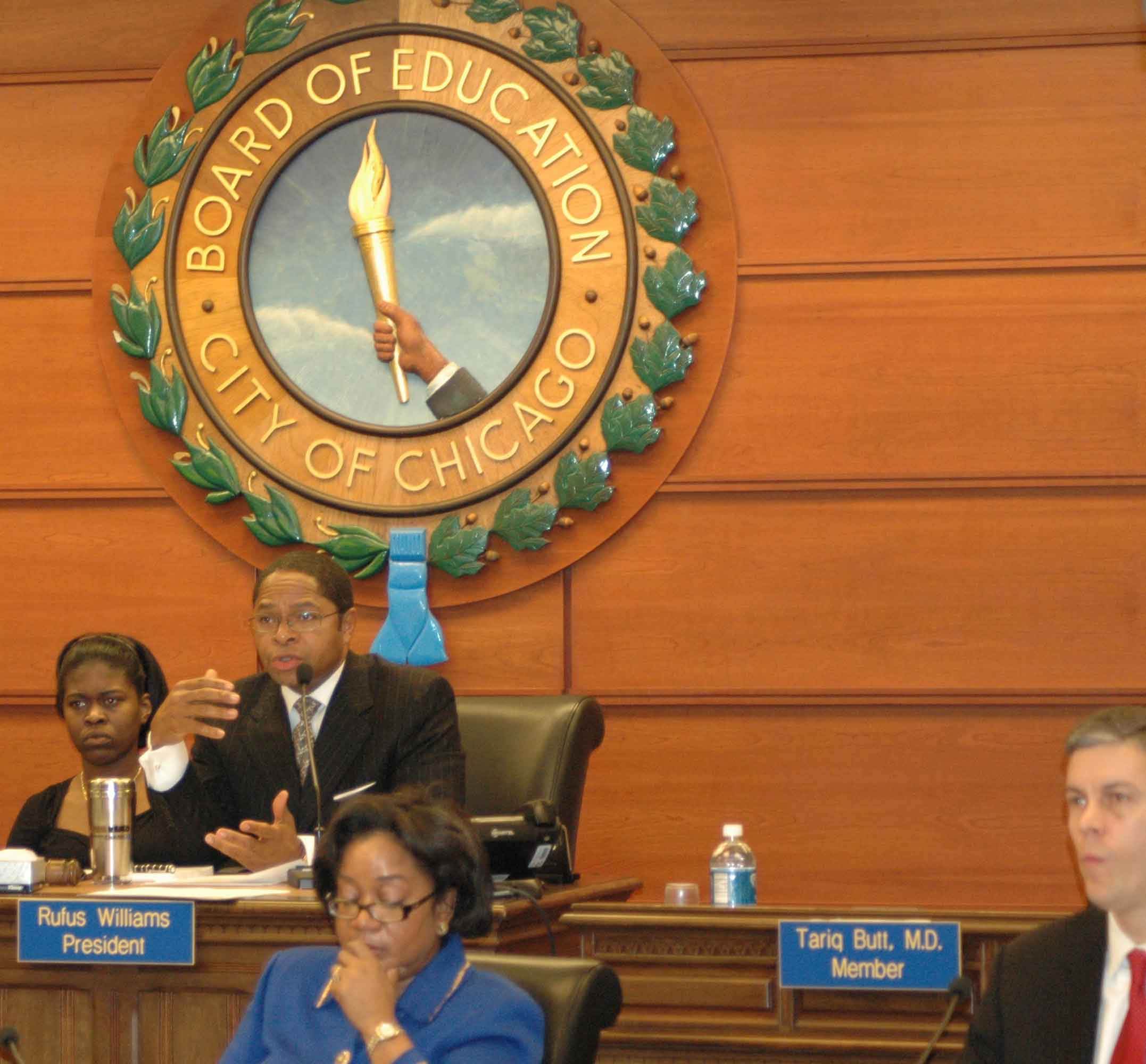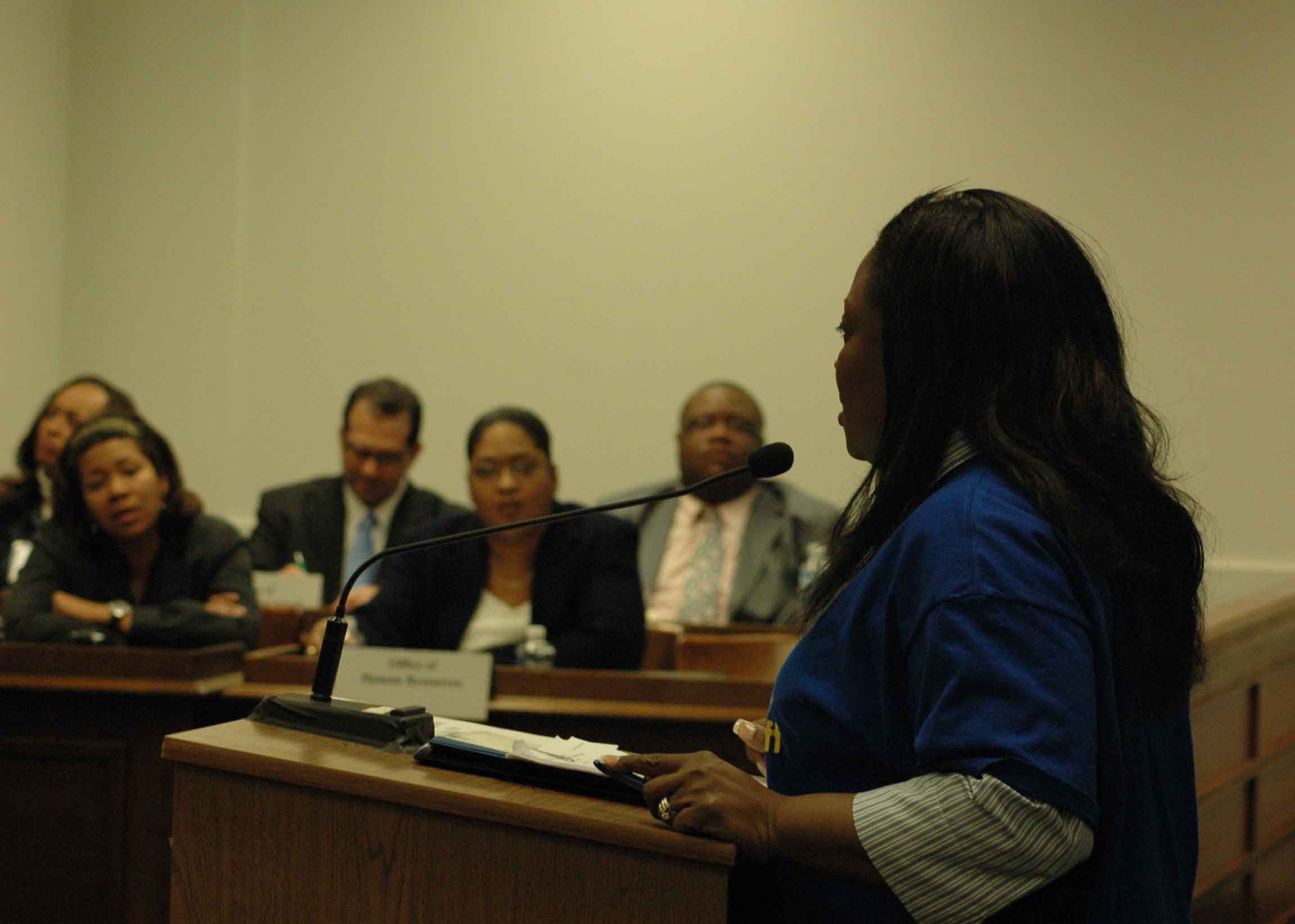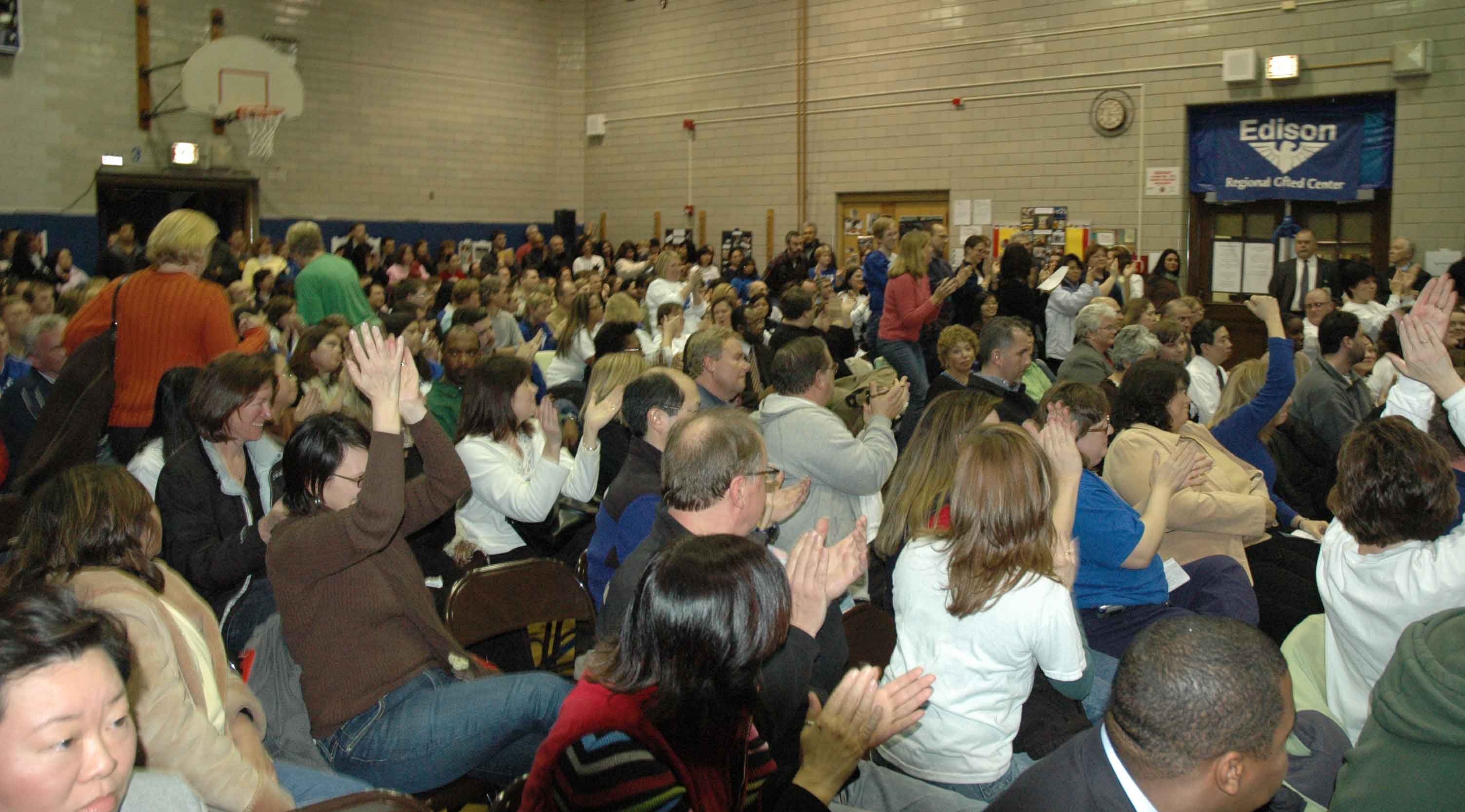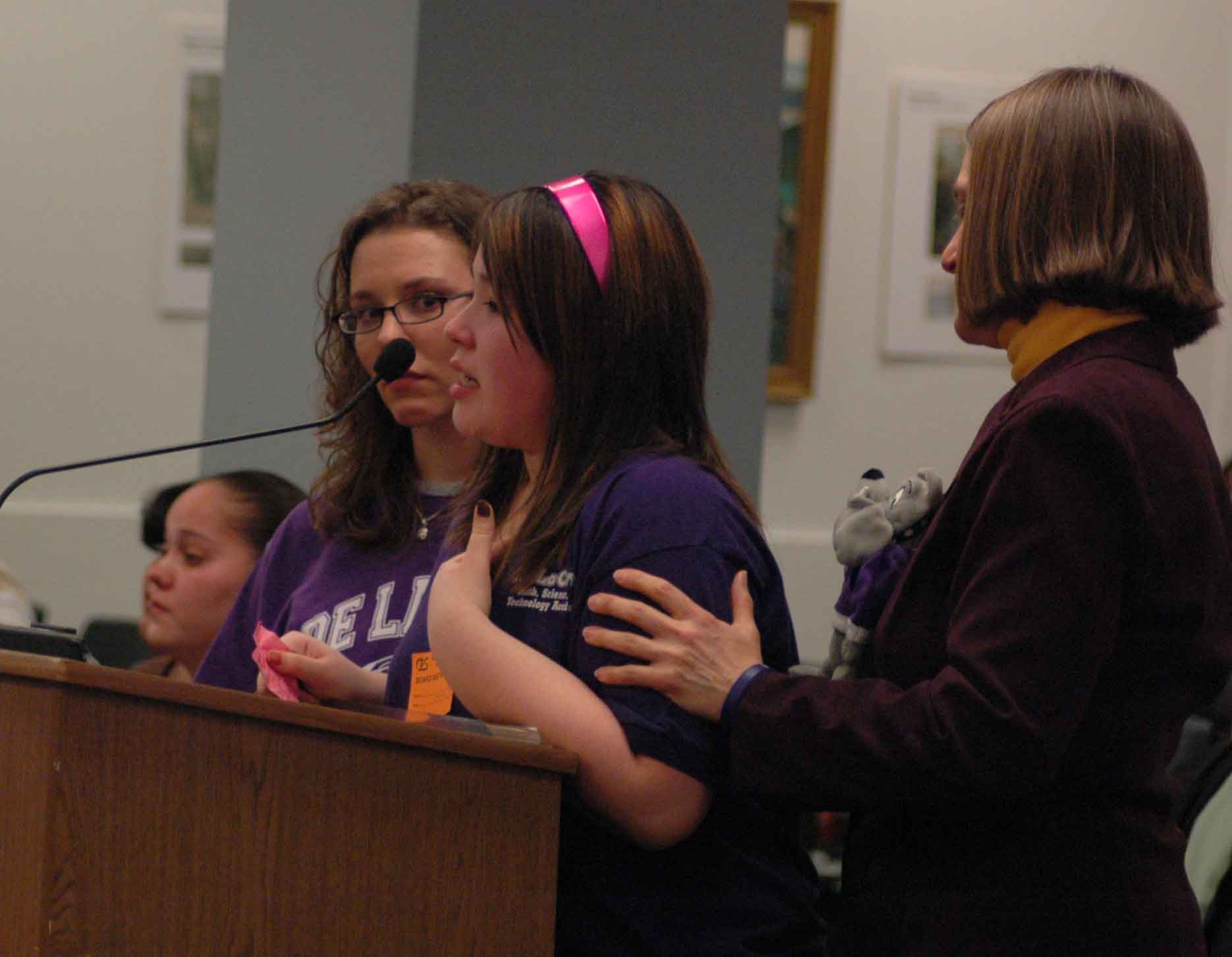Did Board president lie to parents and teachers about the 'process' when the February closings were a 'Done Deal!'?
Despite the fact that the President of the Chicago Board of Education told protesting parents at the Board’s January 2008 meeting that the proposed massive reorganizations of 19 public schools was not a “done deal,” the deal was done before the public hearings on the different deals were held. Chicago Board of Education President Rufus Williams told parents, teachers, principals, students, and community leaders that they should “respect the process” and participate in the school closing hearings that were scheduled from February 4 through February 16, 2008. But the seven members of the Chicago Board of Education avoided the hearings. So did the school system’s two “CEOs” — “Chief Executive Officer” Arne Duncan and “Chief Education Officer” Barbara Eason-Watkins. The process, as many parents and teachers suggested, was simply a rubber stamp for the school system's bureaucracy led by Duncan. More than a thousand people participated in the hearings and produced written records ranging from children’s letters to petitions signed by hundreds of people during the actual hearings. Nevertheless, the members of the Board voted unanimously to approve all but one of the recommendations of the 19 proposed by Arne Duncan the day after the Board met in January.
By the end of February 2008, Chicago had witnessed one of the largest outpourings of public participation in the schools in the city’s history. Not only did the members of the Board of Education ignore the meetings and hearings across the city at which the outpourings took place, but they also did not read the thousands of pages of materials which were provided by citizens in good faith to the hearing officers. The hearings officers acted on the Board’s behalf at each of the hearings and led the public to believe that their reports would be read by the members of the Board of Education. Above: January 23, 2008. When parents from Edison, Abbott, Andersen and other schools came to the January 2008 Board of Education meeting to challenge the Board’s plans to change, close, or relocate 19 public schools, Board President Rufus Williams (above, with hand outstretched arguing with Edison parents) argued with parents. Williams told parents to participate in what he called “the process” including public hearings on the closings which were held between February 4 and February 16 across Chicago. What Williams didn’t say was that the “process” was over by the January 23. because CEO Barbara Eason - Watkins (left, in foreground) and CEO Arne Duncan (right in foreground) had already prepared all of the policy changes and “data” that would be rubber stamped by the hearing officers and Board members the following month. Substance photo by George N. Schmidt.
Above: January 23, 2008. When parents from Edison, Abbott, Andersen and other schools came to the January 2008 Board of Education meeting to challenge the Board’s plans to change, close, or relocate 19 public schools, Board President Rufus Williams (above, with hand outstretched arguing with Edison parents) argued with parents. Williams told parents to participate in what he called “the process” including public hearings on the closings which were held between February 4 and February 16 across Chicago. What Williams didn’t say was that the “process” was over by the January 23. because CEO Barbara Eason - Watkins (left, in foreground) and CEO Arne Duncan (right in foreground) had already prepared all of the policy changes and “data” that would be rubber stamped by the hearing officers and Board members the following month. Substance photo by George N. Schmidt.
In fact, at the time the Board members voted in favor of Duncan’s proposals at their regular monthly meeting on February 27, 2008, not one of them had read the materials presented by parents, teachers, principals, students, and community leaders on behalf of the schools that were slated for closing or reorganization. An ongoing investigation by Substance has established that the members of the Board had never even received the complete record of each of the hearings, despite the fact that at each hearing the hearing officers, reading from a script prepared by the Board’s Law Department, informed the public that the “record” would be “kept open” until a certain date and time, and that any submissions for the “record” would be presented to the Board along with the report of the hearing officers.
Not only was it a “Done deal” — as many parents suspected — but it was done in the most cynical fashion. Thousands poured out their feelings and marshaled their facts in a dramatic outpouring of support for public schools from one end of Chicago to another, while nine of the ten most powerful people in public education in Chicago didn’t even bother to look at the materials that people had assembled for them.
As late as a month after the Board’s February 27 vote, none of the highly paid officials are CPS headquarters could even show members or the public the complete record of each of the hearings. At best, the members of the Board received a brief (between six and 20 pages) “report” from the well paid hearing officers prior to their vote. Not one of the top executives of CPS and not one member of the Board of Education attended any of the hearings. Not one of them read the complete report of the “independent hearing officer” after thousands of ordinary Chicago people (including hundreds of children) worked day and night throughout the month of February 2008 to make their case clear to the “independent hearing officer” at each of the hearings on those 19 schools on Arne Duncan’s hit list. Above: February 21, 2008. Principals joined parents, students, community leaders, and their staffs to defend their schools and protest the Board’s plans during the February hearings. On February 21 (above), Fulton Elementary School Principal Warletta Johnson Brookins tried to address “The Board” (background) about the progress made at Fulton. Most of those who spoke at the hearings didn’t even realize that the people sitting in the “Board” seats were mid-level CPS bureaucrats who had been ordered to attend the hearings by senior staff. Not one Board member listened to any of the presentations. Like many of the schools, Fulton filled the Board chambers for the hearing. Although CEO Arne Duncan claimed that Fulton had to be “turned around” because it was a feeder school to the “failing” Harper High School, Fulton pointed out that it sent its eighth graders to Tilden High School — not Harper. It didn’t matter. On February 27, without reading any of the Fulton testimony or exhibits, the Board voted unanimously to close Fulton and fire everyone in it as part of “turnaround.” Substance photo by George N. Schmidt.
Above: February 21, 2008. Principals joined parents, students, community leaders, and their staffs to defend their schools and protest the Board’s plans during the February hearings. On February 21 (above), Fulton Elementary School Principal Warletta Johnson Brookins tried to address “The Board” (background) about the progress made at Fulton. Most of those who spoke at the hearings didn’t even realize that the people sitting in the “Board” seats were mid-level CPS bureaucrats who had been ordered to attend the hearings by senior staff. Not one Board member listened to any of the presentations. Like many of the schools, Fulton filled the Board chambers for the hearing. Although CEO Arne Duncan claimed that Fulton had to be “turned around” because it was a feeder school to the “failing” Harper High School, Fulton pointed out that it sent its eighth graders to Tilden High School — not Harper. It didn’t matter. On February 27, without reading any of the Fulton testimony or exhibits, the Board voted unanimously to close Fulton and fire everyone in it as part of “turnaround.” Substance photo by George N. Schmidt.
The four people who actually appeared at the hearings between February 4 and February 16 and “testified” were (a) someone from the Law Department (some low level mope — never one of their top dogs; definitely never Rocks); (b) Jimm Dispensa from “Demographics” (without ever testifying as to what training and credentials he has to be the “Demographer” for the third largest school system in the USA; (c) someone from “Research and Accountability” (not always Ginger Reynolds, who, like Dispensa, was not asked how she became chief of “Research, Evaluation and Accountability” for the third largest school system in the USA, let alone about all the numbers she was spinning out of Power Point); and (d) someone from Specialized Services (but not Renee Grant Mitchell). Pickens was also at every hearing.
At all of the hearings attended by Substance reporters and from fraternal news organizations, we also observed David Pickens, of Duncan’s staff. Not one Board member went to any of the hearings. Rufus Williams made some talk in January about “respecting the process” (while he belittled the parents — especially the Edison parents — who charged that Barbara Eason-Watkins had proclaimed it was a “done deal”) at the January 23 meeting. But Rufus Williams had to know that the “process” was over as he spoke that day, and by the time the hearings were scheduled. The “process” that mattered was the secret process the Board went through with its top executives (Arne Duncan; Barbara Eason-Watkins; Patrick Rocks; Renee Grant Mitchell; and Ginger Reynolds) to come up with the “policies” (all of which were crafted to make anything legal) and the hit list. Every one of those policies was crafted in secret, discussed in secret, and then approved unanimously and without debate in less than 60 seconds at a “public” meeting of the Board. More than 400 Edison parents, students and community members filled the school's gymnasium (above) on Chicago's northwest side for the February 8 hearing on the proposal to move the school seven miles to the east. The move deprived Edison of a site it had successfully utilized for 25 years. The claim by Arne Duncan and the Board of Education was that the Edison building was needed to "relieve overcrowding" on the Northwest side. The overwhelming majority of those who testified asked that Edison be kept in its present site, but the "done deal" was in fact in place, despite the claims by Board President Rufus Williams. Many noted that Edison's isolated location (north of the Kennedy Expressway and west of Harlem Ave.) made it irrelevant to the most serious overcrowding on the northwest side, which was more intense to the south and west of the Edison site. Duncan and Williams (joined by Alderman Patrick Doherty) got their way, however, and in September 2008 Edison will be housed inside the Albany Park Multicultural Academy. Substance photo by George N. Schmidt.
More than 400 Edison parents, students and community members filled the school's gymnasium (above) on Chicago's northwest side for the February 8 hearing on the proposal to move the school seven miles to the east. The move deprived Edison of a site it had successfully utilized for 25 years. The claim by Arne Duncan and the Board of Education was that the Edison building was needed to "relieve overcrowding" on the Northwest side. The overwhelming majority of those who testified asked that Edison be kept in its present site, but the "done deal" was in fact in place, despite the claims by Board President Rufus Williams. Many noted that Edison's isolated location (north of the Kennedy Expressway and west of Harlem Ave.) made it irrelevant to the most serious overcrowding on the northwest side, which was more intense to the south and west of the Edison site. Duncan and Williams (joined by Alderman Patrick Doherty) got their way, however, and in September 2008 Edison will be housed inside the Albany Park Multicultural Academy. Substance photo by George N. Schmidt.
A DVD produced by Labor Beat is called “It’s a Done Deal.” The phrase “It’s a Done Deal” was what Barbara Eason Watkins told the Edison people before the January 23 meeting. The public attended the hearings expecting that the materials they presented in refutation of the claims by representatives of the Duncan administration would carry some legal weight. But two of the key officials who presented the “data” upon which the Board’s cases rested were not ever expected to be questioned about their information, let alone undergo cross examination about the validity of their claims and the basis of their analysis. In addition to a representative of the Law Department, the Board was represented by Ginger Reynolds (the Board’s most recent “Chief Accountability Officer”) and Jimm Dispensa (who is currently identified as “Demographer”). Above: February 14, 2008. Some of the most poignant testimony during the hearings that the Board members ignored came from special education parents and students who tried to tell “The Board” during the hearings how much progress they had made at the schools that were being closed or radically changed. Above, special education student Illiana Mojica began crying during her explanation of how the teachers at De La Cruz had changed her life for the better and given her hope. Members of the Chicago Board of Education who voted to close De La Cruz and 17 other schools did not read the hundreds of letters and petitions that were signed by students from the schools under attack by the Duncan administration. Substance photo by George N. Schmidt.
Above: February 14, 2008. Some of the most poignant testimony during the hearings that the Board members ignored came from special education parents and students who tried to tell “The Board” during the hearings how much progress they had made at the schools that were being closed or radically changed. Above, special education student Illiana Mojica began crying during her explanation of how the teachers at De La Cruz had changed her life for the better and given her hope. Members of the Chicago Board of Education who voted to close De La Cruz and 17 other schools did not read the hundreds of letters and petitions that were signed by students from the schools under attack by the Duncan administration. Substance photo by George N. Schmidt.
As long as Reynolds and Dispensa didn’t have to answer any questions or submit to cross examination about the lies they told at each hearing — usually by leaving out very very important stuff, never directly, things moved forward. And the “hearing officers” didn’t even ask how Reynolds and Dispensa came to be there (something not one of them — they’re all lawyers — would be fired for doing by their firms if they had gone to a trial and neglected to establish the bona fides of their witnesses). As many observers noted, however, at least David Pickens and Jimm Dispensa were at the hearings. Duncan and Eason Watkins don’t like to be around when their victims’ blood is being spilled.
The following people were not at the hearings:
Arne Duncan
Barbara Eason Watkins
Patrick Rocks
Rufus Williams
Norman Bobins
Tariq Butt
Alberto Carero Jr.
Peggy Davis
Clara Munana
Roxanne Ward
Richard M. Daley
For more than five weeks, Substance has been assembling the complete record of each of the hearings as prepared by officials at various departments in CPS. The record of each hearing is supposed to include the following information:
-- A transcript of the testimony of everyone who signed up to speak.
-- All documents provided by the speakers, and documents provided by people who could not attend the hearings but who wanted to provide input
-- The official materials placed into the record by representatives of CPS, viz., the Law Department, Specialized Services, Research and Accountability, and Demographics.
-- Any additional materials that the public wanted to present.
Not only were the materials not read by the Board members before their February 27 vote, the materials were not even available to the Board members at the time the Board published the agenda for the meeting at which the vote was taken. But the thousands of people — ranging in age from as young as three or four years old to as old as people in their eighties — didn’t know that their work and their pleas were slated to be ignored. Even though they were talking to a group of mid-level functionairies during the hearings, they demonctrated that even in Chicago, democracy is still alive and well in public schools.

